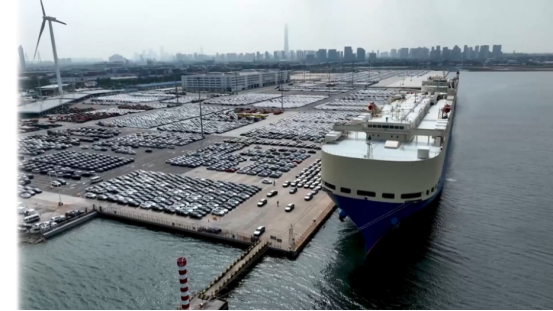Standing at a critical juncture of the global automotive industry's transformation, China's used car exports are embracing new opportunities.
At present, China's used car export is in a golden period of overlapping policy dividends and market explosion. With over 400 million vehicles in stock, a mature supply chain system and high cost-performance model options, China's used car export has a solid foundation, said Luo Lei, vice president of the China Automobile Dealers Association, at the 2025 China Used Car Export Ecosystem Conference held recently.
Data shows that in 2024, China's used car exports have exceeded 400,000 units, reaching over 160 countries and regions, emerging as a new force driving automotive consumption and promoting industrial upgrading. At the same time, China's used car exports urgently need to establish a collaborative development pattern guided by the government, led by enterprises, and empowered by associations, to break through overseas market barriers with standardized and internationalized service systems and form a more competitive global used car circulation network.
Gao Dewu, CEO of CAR Inc, said that the global automotive circulation system is undergoing rapid changes. A reliable vehicle source is the cornerstone of the ecosystem, and transparent information is the bridge of trust. In the second half of used car exports, it is not simply about selling vehicles, but about "selling the ecosystem".
Huang Ruoyu, the president of the Used Car Export Branch of CADA's Used Car Export Committee, stated that China is accelerating the global automotive trade process with a dual output of "technology and production capacity", and this trend is irreversible. With the "triple crown" of production, sales and exports, and a total export volume of 6.4 million vehicles globally, China is reshaping trade flows and laying the foundation for the market structure. On this basis, Chinese automakers are deeply cultivating the global market with differentiated strategies. In the Middle East market, they focus on the "reliability of fuel vehicles"; in the Central and European market, they focus on "infrastructure compatibility of electric vehicles"; and in the Latin American market, they emphasize the "high cost-performance advantage". This three-pronged strategy is continuously expanding the penetration and influence of Chinese automobiles in the global market, bringing new opportunities to the used car market.
Li Jia, vice president of China Auto Rental, believes that China's used car exports need to overcome three major hurdles: the professional barrier, the trust barrier, and the scale barrier, in order to establish an international competitive edge. Based on China Auto Rental's overseas expansion experience, he has proposed three key paths: first, proactively "go global" by setting up direct sales networks in six key countries through port forward warehouses, overseas warehouses, and overseas offices, covering more than 30 surrounding countries and regions; second, integrate resources and form a "vehicle source working group" with domestic vehicle source providers to share overseas business opportunities and improve matching efficiency; third, focus on "standard-like products", promoting the transformation of non-standard used cars into standardized ones through the "four same" strategy of the same year, the same mileage, the same condition, and the same price, to enhance market trust.
"Coordinated efforts from supporting enterprises such as institutional vehicle sources, logistics, and after-sales services are needed. By following the path of 'institutional vehicle sources leading the way, supporting services following up, and trading platforms going global', we can jointly promote the export of second-hand vehicles to a new level," said Li Jia.
As one of the core achievements of the 2025 China Used Car Export Ecosystem Conference, the Used Car Institutional Vehicle Supply Export Task Force, jointly initiated by the China Automobile Dealers Association and China Auto Rental, was officially launched, marking the official entry of China's used car export into a new stage of "ecological, standardized and brand-oriented" development.
As a member organization under the Used Car Export Branch of the China Automobile Dealers Association, the working group's first batch of members includes 23 automakers, 7 financial leasing institutions, 5 leasing and mobility enterprises, and 3 dealers, covering all key players from vehicle supply, financial services to circulation services. It will become one of the most representative industrial collaboration platforms in the current domestic used car export sector. It is reported that the core goal of the working group is to integrate the scattered institutional vehicle sources, technologies and channel resources into "one network", transforming used car exports from "individual battles" to "grouping for overseas expansion", and jointly building the overseas reputation of Chinese used cars, becoming the preferred channel for overseas bulk purchases.
Guangdong is one of the provinces with the largest number of cars in China. Yan Fei, the president of the Guangdong Automobile Circulation Association, said that relying on the market foundation, Guangdong has accelerated the export of second-hand cars through policy support and service optimization. In the first seven months of this year, Guangdong exported 46,000 second-hand cars, exceeding the total of last year. Zhao Zhe, vice president of China Auto Rental, said that as the largest car rental company in China, China Auto Rental has built a full-chain ecosystem of "buy, rent, repair and sell", covering new car procurement, rental services, its own maintenance system and domestic and international second-hand car layouts.
Xu Changming, a senior economist at the National Information Center, analyzed that the core driving force for global automotive demand growth is accelerating its shift from developed countries to emerging markets. Chinese domestic brands have performed strongly in regions such as Russia, Central Asia, the Middle East, and ASEAN. New energy vehicles have a market share of over 50% in emerging markets. Although challenges such as EU barriers lie ahead, with the improvement of the competitiveness of domestic brands, the improvement of local production and services, the prospects for the full-scale overseas expansion of China's automotive industry are broad.
Declaration: This article comes fromEconomic Daily.If copyright issues are involved, please contact us to delete.
